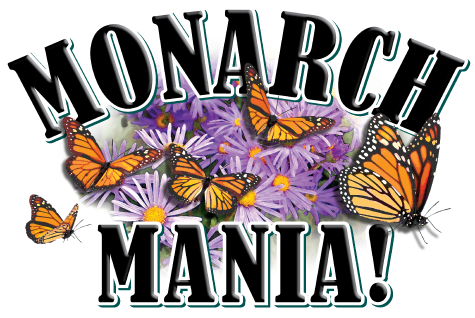
Monarch Mania
The Plight of Pollinators
The National Academy of Sciences report, Status of Pollinators in North America, states that pollinator declines are undeniably occurring due to three main causes:
- Habitat loss
- Pesticide use
- Disease (especially in honey bees)
Amongst the pollinators in danger, the once-common monarch butterfly has had its population plummet by around 90%.
Why We Need Pollinators
- Flower & Food Reproduction: Pollinators are responsible for the reproduction of 90% of flowering plants and 1/3 of human food crops.
- Vital to the Ag Economy: Domestic honeybees pollinate approximately $10 billion worth of crops in the U.S. each year. Bee poisonings from pesticides result in annual losses of $14.3 million.
- Pollinators Support Biodiversity: There is a positive correlation between plant diversity and pollinator diversity.
- Linked to Human Quality of Life: Pollinators sustain natural ecosystems and preserve the quality of human and all other species' lives.
Source: North American Pollinator Protection Campaign
Saving Our Pollinators: Monarch Mania!
 The Lime Creek Nature Center is joining the effort to save our pollinators with our Monarch Mania program. Monarch Mania's goal is to assist citizens, schools, businesses, and communities with planting native plants, including milkweed, on their properties to provide critical habitat and help turn the tide for monarchs and other pollinators. These pollinators are a very important component of our food supply, as noted above, and their declining numbers should concern everyone.
The Lime Creek Nature Center is joining the effort to save our pollinators with our Monarch Mania program. Monarch Mania's goal is to assist citizens, schools, businesses, and communities with planting native plants, including milkweed, on their properties to provide critical habitat and help turn the tide for monarchs and other pollinators. These pollinators are a very important component of our food supply, as noted above, and their declining numbers should concern everyone.
Why Native Plants?
Restoring a struggling wildlife species almost always starts with restoring their habitat. Establishing milkweed and pollinator plant gardens in backyards, fields, and roadsides throughout the Midwest will make a huge impact in reversing the alarming decline of our beloved monarchs and pollinator species.
Join the Cause: What to Plant
Join our Monarch Mania program and help our local butterflies by planting native wildflowers! Native flowers are adapted to growing in Iowa, so they do not need fertilizer or heavy watering. Plus, they preserve Iowa's natural prairie history!
The Dietary Preferences of Caterpillars & Butterflies
Butterflies have four stages in their life cycle: egg, larva, pupa, and adult. The egg and pupa do not eat, so no plant recommendations there! But the larva (caterpillar) eats plants, and some are very picky. For example, monarch caterpillars will only eat milkweed species. Others have broad taste palates and will eat a variety of plants. Adults (butterflies) are the ones who eat what you probably traditionally picture a butterfly consuming: nectar plants (flowers).
When planning your garden, think diversity. Incorporate a variety of species that will provide blooms from spring until fall, feeding caterpillars and butterflies alike. A garden with many different species of plants will attract more pollinators than one without. View our garden registration form for a list of recommended native plants.
Join the Cause: What Not to Do
Insecticides? Skip It!
Remember, a pollinator garden is a little different than the gardens most of us are used to. After all, in this case, you want your visitors to eat your garden! So as those monarch butterflies are busily munching away on your milkweed, you needn't fret — just smile and enjoy the show!
Say no to insecticides. Insecticides such as malathion, Sevin, and diazinon are marketed to kill insects. Don't use these materials in or near the butterfly garden — or even better, don't use them anywhere on your property. Even "benign" insecticides such as Bacillus thuringiensis are lethal to butterflies. We want to create gardens that benefit their population, not contribute to their decline.
Fall Yard Clean-Up? Good News: Skip It!
This might sound counterintuitive, but come fall, don't clean up your leaves and stems. Fall yard clean-up actually does more harm than good when it comes to insects! Many insects spend winter in the dried stems of flowers and grasses. And even more of them use leaf litter as a safe haven, so take a break this fall from raking and leave the fallen leaves for the bugs. It's a win-win!

Register Your Garden
Become a Monarch Mania garden! These gardens don't need to be large; all they need is one native nectar species and one host plant species.
When registering your garden, you'll have the option to request a certificate and certification sign. Your garden does not need to be a new garden to be certified. When you certify, you will receive a Monarch Mania pollinator garden certificate and, with a $10 fee, you can purchase a sign to display in your garden! Participants must be able to pick up their signs from the nature center at 3501 Lime Creek Rd. in Mason City.
Mania Map
Registered gardens are added to the Mania Map. See how your garden connects with others in saving our pollinators!
Funding
The Monarch Mania program is funded by Lime Creek Nature Center’s Maxine Sanberg Memorial Fund. Maxine was a long-time volunteer, nature center board member, and strong supporter of the Lime Creek Nature Center. She was also an avid photographer and took many pictures of monarch butterflies over the years.


